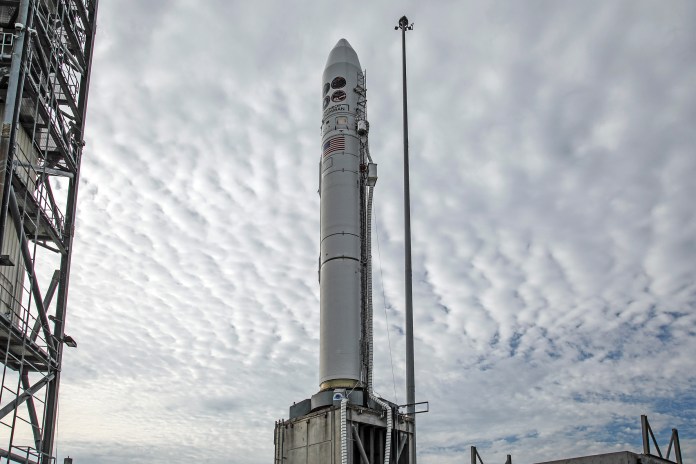Northrop Grumman stands ready to launch the classified NROL-129 mission, consisting of four payloads designed and built by the National Reconnaissance Office. Liftoff is targeted for Wednesday, 15 July in a launch window that opens at 09:00 EDT (13:00 UTC).
This will be the first launch of the Minotaur IV from the Mid-Atlantic Regional Spaceport (MARS) at NASA’s Wallops Flight Facility, which is located on the eastern shore of Virginia near the town of Wattsville.
Preparations for launch began in earnest more than a month and a half ago, as teams from Northrop Grumman and the National Reconnaissance Office (NRO) took possession of various elements for the flight, including all of the solid propellant motor segments which were delivered and stacked in June.
After completing all pre-flight activities, including a joint Mission Dress Rehearsal on Friday, 10 July, Northrop Grumman entered final closeout operations for the rocket over the weekend.
For launch, teams came on console in the early morning hours and started the countdown at 04:00 EDT (08:00 UTC).
“You know on a solid rocket motor vehicle that launches from the ground, it’s a fairly straightforward countdown,” said Kurt Eberly, Program Director, Small and Medium Space Launch for Northrop Grumman, in a one-on-one interview with NASASpaceflight.
“We power up all the avionics. We initialize all the computers and the different processors on each of the stages. We do some wiggle tests of the Thrust Vector Controllers using ground power. And then you know about an hour before launch, we start an initialization of the navigator, the inertial navigator.”
“That’s a ring laser gyro assembly. And so we start a gyro-compass algorithm that’s basically using gravity and the rotation of the Earth to go through an algorithm to basically initialize the position and instrument of the inertial navigation set.”
During practice countdown and vehicle power ups for checkout operations, teams took careful note of how the inertial navigator powered up and how it was aligned. “So we have those written down carefully,” said Mr. Eberly, “and we’ll compare the launch-day alignment to the prior alignment and make sure it’s within tolerance.”
As always, though, all pre-launch activity won’t be confined to the ground.
“Getting close to launch, there’s a bunch of range activity. We’ll be flying balloons pretty much every hour to get a sense of the winds aloft. And [then we’ll] do some evaluation of the wind profile on that day.”
The Range Weather Officer will provide the wind profile that allows the Guidance, Navigation and Control teams to check that upper level winds and their associated shear are within safety limits for the Minotaur IV.
After that, teams will remotely arm the ordnance on the Minotaur IV, which will be followed by turning on ordnance power. A series of checkouts will then follow to clear Minotaur IV for launch.
Minotaur IV on Pad-0B at MARS the day before its scheduled 15 July 2020 launch of NROL-129. (Credit: Northrop Grumman/Thom Baur)
When the count reaches zero, Minotaur’s IV first stage will ignite on Pad-0B and the solid motor will reach full thrust within 0.2 seconds with liftoff following nearly instantaneously.
“It’s a very rapid event compared to a liquid. There is no spooling up of the turbopumps or anything like that. You ignite it, and you are off and going. And that’s just typical of a strategic missile. It’s not hanging around for long,” said Mr. Eberly.
Minotaur IV itself is a modified Peacekeeper intercontinental ballistic missile. The first stage is an SR-118 solid motor that delivers 2,200 kN (490,000 lbf) thrust.
The stage will then hand off to the SR-119 second stage, another solid motor that delivers 1,365 kN (307,000 lbf) thrust for 54 seconds.
The third stage is an SR-120. Delivering 329 kN (74,000 lbf) thrust and burning for 62 seconds, this will complete the first part of the ascent, after which the fourth stage will enter a prolonged coast to apogee.
During the first three stages of flight, communication with the rocket will be routed through tracking stations in Bermuda and at Coquina, North Carolina.
However, the long coast up to apogee will place the fourth stage too far down range to communicate with those tracking stations when it ignites. To solve that issue, the rocket will communicate upwards with NASA’s Tracking and Data Relay Satellite (TDRS) network in geostationary orbit.
Due to the classified nature of the mission, no information is available on the exact time when the final stage will reach apogee and ignite the solid propellant Orion 38 motor.
Because we love launching rockets more than anything, we’re helping our partners @NatReconOfc launch NROL-129 from MARS pad 0B tomorrow!
Not the planet but @NASA‘s pad named the Mid-Atlantic Regional Spaceport at the Wallops Flight Facility in Virginia.https://t.co/cPQAHP4CaP
— United States Space Force (@SpaceForceDoD) July 15, 2020
Regardless, thanks to precise mass measurements of the Orion 38, a precise knowledge of not just the propellant mixture but exactly how hot and fast that propellant mixture burns, and the exact mass of the four classified payloads will result in the Orion 38 inserting the mission into a very precise orbit despite being a solid rocket motor that must burn to depletion once ignited.
Confirmation of successful payload deployment and mission completion might come from Northrop Grumman or the NRO itself — or from orbital tracking information as is sometimes the case with classified missions.
The next two NRO missions, NROL-44 and NROL-101, are slated to launch in August and September from Cape Canaveral Air Force Station, Florida, on United Launch Alliance’s Delta IV Heavy and Atlas V 531 rockets, respectively.
(Lead image: Northrop Grumman/Thom Baur)
The post Northrop Grumman set to launch NROL-129 from MARS appeared first on NASASpaceFlight.com.
– Advertisement –
